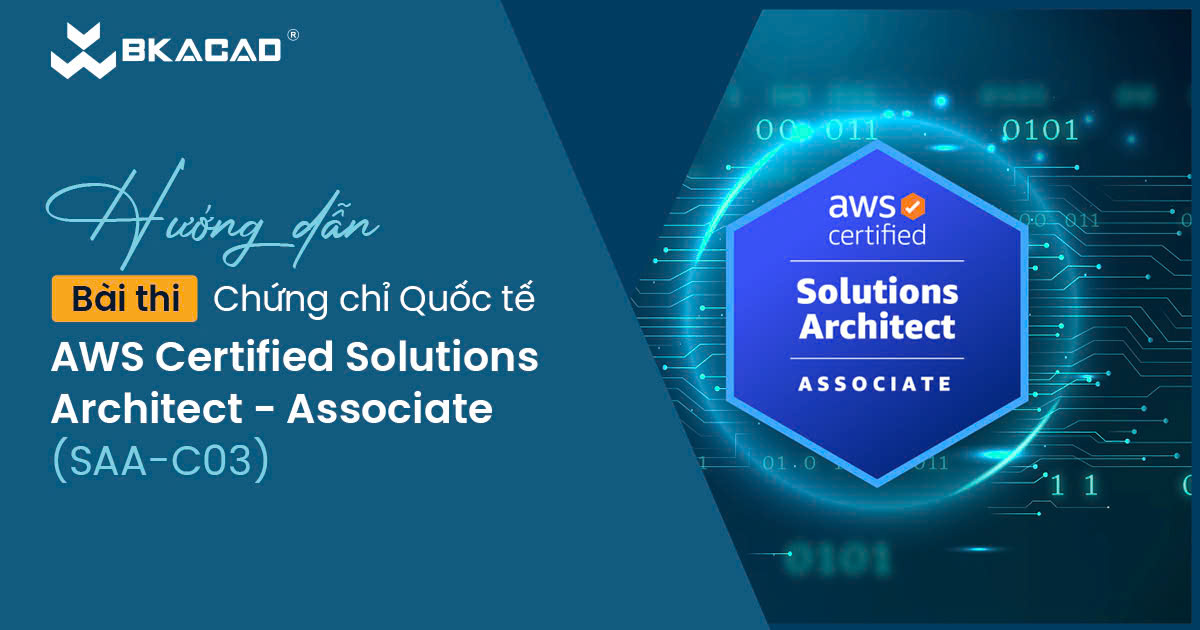Tin tức
HƯỚNG DẪN BÀI THI CHỨNG CHỈ QUỐC TẾ AWS CERTIFIED SOLUTIONS ARCHITECT - ASSOCIATE (SAA-C03)
HƯỚNG DẪN BÀI THI CHỨNG CHỈ QUỐC TẾ AWS CERTIFIED SOLUTIONS ARCHITECT - ASSOCIATE (SAA-C03)
18/08/2025 16:56

AWS Certified Solutions Architect - Associate (SAA-C03) xác thực khả năng của thí sinh trong việc thiết kế các giải pháp dựa trên Khung Kiến trúc chuẩn của AWS.
Kỳ thi cũng xác nhận khả năng của thí sinh trong việc hoàn thành các nhiệm vụ sau:
• Thiết kế các giải pháp tích hợp dịch vụ AWS để đáp ứng các yêu cầu kinh doanh hiện tại và các nhu cầu dự kiến trong tương lai
• Thiết kế các kiến trúc bảo mật,khả năng phục hồi, hiệu suất cao và tối ưu hóa chi phí
• Đánh giá các giải pháp hiện có và xác định các cải tiến
1. Thời gian thi: 130 phút
2. Hình thức thi: 65 câu hỏi trắc nghiệm
3. Chi phí thi: 150 USD
4. Tùy chọn tham gia thi: Tại trung tâm khảo thí hoặc thi online
5. Ngôn ngữ sử dụng: Tiếng Anh, tiếng Pháp (Pháp), tiếng Ý, tiếng Nhật, tiếng Hàn, tiếng Bồ Đào Nha (Brazil), tiếng Tây Ban Nha (Mỹ Latinh), tiếng Tây Ban Nha (Tây Ban Nha), tiếng Trung giản thể và tiếng Trung phồn thể
6. Mã môn thi: SAA-C03
7. Thời hạn của chứng chỉ:
- Chứng chỉ này có giá trị trong 3 năm. Trước khi chứng chỉ hết hạn, bạn có thể chứng nhận lại bằng cách vượt qua phiên bản mới nhất của bài thi này hoặc đạt được AWS Certified Solutions Architect – Professional để tự động chứng nhận lại chứng nhận cấp Associate này.
- Chi phí chứng nhận lại: Thí sinh được nhận voucher 50% để thi chứng nhận lại trên tài khoản của mình.
8. Nội dung kỳ thi:
Trong kỳ thi có hai dạng câu hỏi:
- Multiple choice (Trắc nghiệm một đáp án đúng): Có một đáp án đúng và ba đáp án sai (gọi là distractors).
- Multiple response (Trắc nghiệm nhiều đáp án đúng): Có từ hai đáp án đúng trở lên trong số năm hoặc nhiều hơn các phương án trả lời.
Thí sinh cần chọn một hoặc nhiều đáp án phù hợp nhất để hoàn thành câu phát biểu hoặc trả lời câu hỏi.
Distractors (đáp án nhiễu hoặc đáp án sai) là những phương án mà thí sinh thiếu kiến thức hoặc kỹ năng có thể sẽ chọn nhầm. Chúng thường là những phương án có vẻ hợp lý và liên quan đến nội dung đề thi.
Các câu hỏi không trả lời sẽ được tính là sai.
Kỳ thi gồm 50 câu hỏi được tính điểm vào kết quả cuối cùng.
9. Nội dung không tính điểm
- Kỳ thi bao gồm 15 câu hỏi không tính điểm, không ảnh hưởng đến kết quả của bạn.
- AWS thu thập thông tin về hiệu suất làm bài của thí sinh đối với những câu hỏi này nhằm đánh giá và xem xét sử dụng chúng làm câu hỏi tính điểm trong các kỳ thi tương lai.
- Những câu hỏi không tính điểm này không được đánh dấu trong đề thi.
10. Kết quả kỳ thi
- Kỳ thi AWS Certified Solutions Architect – Associate (SAA-C03) được đánh giá theo hình thức Đạt hoặc Không đạt.
- Bài thi được chấm dựa trên tiêu chuẩn tối thiểu do các chuyên gia AWS xây dựng, tuân theo các thông lệ và hướng dẫn tốt nhất của chứng chỉ quốc tế.
- Kết quả của bạn được báo cáo dưới dạng điểm quy đổi từ 100 đến 1.000. Điểm tối thiểu để đạt là 720. Điểm số thể hiện hiệu suất làm bài tổng thể của bạn và cho biết bạn có đạt hay không.
- Báo cáo kết quả có thể bao gồm bảng phân loại hiệu suất của bạn ở từng phần của kỳ thi.
Kỳ thi áp dụng mô hình chấm điểm bù trừ, nghĩa là bạn không cần đạt điểm qua ở từng phần riêng lẻ, mà chỉ cần đạt điểm qua tổng thể kỳ thi.
- Mỗi phần của kỳ thi có trọng số khác nhau, vì vậy một số phần sẽ có nhiều câu hỏi hơn các phần khác. Bảng phân loại này cung cấp thông tin tổng quát để làm nổi bật điểm mạnh và điểm yếu của bạn.
11. Nội dung chính trong bài thi
Kỳ thi bao gồm các miền nội dung và tỷ trọng như sau:
• Domain 1: Design Secure Architectures (30% of scored content)
• Domain 2: Design Resilient Architectures (26% of scored content)
• Domain 3: Design High-Performing Architectures (24% of scored content)
• Domain 4: Design Cost-Optimized Architectures (20% of scored content)
11.1. Domain 1: Design Secure Architectures
- Task Statement 1.1: Design secure access to AWS resources.
Knowledge of:
• Access controls and management across multiple accounts
• AWS federated access and identity services (for example, AWS Identity and Access Management [IAM], AWS IAM Identity Center [AWS Single Sign-On])
• AWS global infrastructure (for example, Availability Zones, AWS Regions)
• AWS security best practices (for example, the principle of least privilege)
• The AWS shared responsibility model
Skills in:
• Applying AWS security best practices to IAM users and root users (for example, multi-factor authentication [MFA])
• Designing a flexible authorization model that includes IAM users, groups, roles, and policies
• Designing a role-based access control strategy (for example, AWS Security Token Service [AWS STS], role switching, cross-account access)
• Designing a security strategy for multiple AWS accounts (for example, AWS Control Tower, service control policies [SCPs])
• Determining the appropriate use of resource policies for AWS services
• Determining when to federate a directory service with IAM roles
- Task Statement 1.2: Design secure workloads and applications.
Knowledge of:
• Application configuration and credentials security
• AWS service endpoints
• Control ports, protocols, and network traffic on AWS
• Secure application access
Security services with appropriate use cases (for example, Amazon Cognito,Amazon GuardDuty, Amazon Macie)
• Threat vectors external to AWS (for example, DDoS, SQL injection)
Skills in:
• Designing VPC architectures with security components (for example, security groups, route tables, network ACLs, NAT gateways)
• Determining network segmentation strategies (for example, using public subnets and private subnets)
• Integrating AWS services to secure applications (for example, AWS Shield, AWS WAF, IAM Identity Center, AWS Secrets Manager)
• Securing external network connections to and from the AWS Cloud (for example, VPN, AWS Direct Connect)
- Task Statement 1.3: Determine appropriate data security controls.
Knowledge of:
• Data access and governance
• Data recovery
• Data retention and classification
• Encryption and appropriate key management
Skills in:
• Aligning AWS technologies to meet compliance requirements
• Encrypting data at rest (for example, AWS Key Management Service [AWS KMS])
• Encrypting data in transit (for example, AWS Certificate Manager [ACM] using TLS)
• Implementing access policies for encryption keys
• Implementing data backups and replications
• Implementing policies for data access, lifecycle, and protection
• Rotating encryption keys and renewing certificates
11.2. Domain 2: Design Resilient Architectures
- Task Statement 2.1: Design scalable and loosely coupled architectures.
Knowledge of:
• API creation and management (for example, Amazon API Gateway, REST API)
• AWS managed services with appropriate use cases (for example, AWS Transfer Family, Amazon Simple Queue Service [Amazon SQS], Secrets Manager)
• Caching strategies
• Design principles for microservices (for example, stateless workloads compared with stateful workloads)
• Event-driven architectures
• Horizontal scaling and vertical scaling
• How to appropriately use edge accelerators (for example, content delivery network [CDN])
• How to migrate applications into containers
• Load balancing concepts (for example, Application Load Balancer)
• Multi-tier architectures
• Queuing and messaging concepts (for example, publish/subscribe)
• Serverless technologies and patterns (for example, AWS Fargate, AWS Lambda)
• Storage types with associated characteristics (for example, object, file, block)
• The orchestration of containers (for example, Amazon Elastic Container Service [Amazon ECS], Amazon Elastic Kubernetes Service [Amazon EKS])
• When to use read replicas
• Workflow orchestration (for example, AWS Step Functions)
Skills in:
• Designing event-driven, microservice, and/or multi-tier architectures based on requirements
• Determining scaling strategies for components used in an architecture design
• Determining the AWS services required to achieve loose coupling based on requirements
• Determining when to use containers
• Determining when to use serverless technologies and patterns
• Recommending appropriate compute, storage, networking, and database technologies based on requirements
• Using purpose-built AWS services for workloads
- Task Statement 2.2: Design highly available and/or fault-tolerant architectures.
Knowledge of:
• AWS global infrastructure (for example, Availability Zones, AWS Regions, Amazon Route 53)
• AWS managed services with appropriate use cases (for example, Amazon Comprehend, Amazon Polly)
• Basic networking concepts (for example, route tables)
• Disaster recovery (DR) strategies (for example, backup and restore, pilot light, warm standby, active-active failover, recovery point objective [RPO], recovery time objective [RTO])
• Distributed design patterns
• Failover strategies
• Immutable infrastructure
• Load balancing concepts (for example, Application Load Balancer)
• Proxy concepts (for example, Amazon RDS Proxy)
• Service quotas and throttling (for example, how to configure the service quotas for a workload in a standby environment)
• Storage options and characteristics (for example, durability, replication)
• Workload visibility (for example, AWS X-Ray)
Skills in:
• Determining automation strategies to ensure infrastructure integrity
• Determining the AWS services required to provide a highly available and/or fault-tolerant architecture across AWS Regions or Availability Zones
• Identifying metrics based on business requirements to deliver a highly available solution
• Implementing designs to mitigate single points of failure
• Implementing strategies to ensure the durability and availability of data (for example, backups)
• Selecting an appropriate DR strategy to meet business requirements
• Using AWS services that improve the reliability of legacy applications and applications not built for the cloud (for example, when application changes are not possible)
• Using purpose-built AWS services for workloads
11.3. Domain 3: Design High-Performing Architectures
- Task Statement 3.1: Determine high-performing and/or scalable storage solutions.
Knowledge of:
• Hybrid storage solutions to meet business requirements
• Storage services with appropriate use cases (for example, Amazon S3, Amazon Elastic File System [Amazon EFS], Amazon Elastic Block Store [Amazon EBS])
• Storage types with associated characteristics (for example, object, file, block)
Skills in:
• Determining storage services and configurations that meet performance demands
• Determining storage services that can scale to accommodate future needs
- Task Statement 3.2: Design high-performing and elastic compute solutions.
Knowledge of:
• AWS compute services with appropriate use cases (for example, AWS Batch, Amazon EMR, Fargate)
• Distributed computing concepts supported by AWS global infrastructure and edge services
• Queuing and messaging concepts (for example, publish/subscribe)
• Scalability capabilities with appropriate use cases (for example, Amazon EC2 Auto Scaling, AWS Auto Scaling)
• Serverless technologies and patterns (for example, Lambda, Fargate)
• The orchestration of containers (for example, Amazon ECS, Amazon EKS)
Skills in:
• Decoupling workloads so that components can scale independently
• Identifying metrics and conditions to perform scaling actions
• Selecting the appropriate compute options and features (for example, EC2 instance types) to meet business requirements
• Selecting the appropriate resource type and size (for example, the amount of Lambda memory) to meet business requirements
- Task Statement 3.3: Determine high-performing database solutions.
Knowledge of:
• AWS global infrastructure (for example, Availability Zones, AWS Regions)
• Caching strategies and services (for example, Amazon ElastiCache)
• Data access patterns (for example, read-intensive compared with writeintensive)
• Database capacity planning (for example, capacity units, instance types,
Provisioned IOPS)
• Database connections and proxies
• Database engines with appropriate use cases (for example, heterogeneous
migrations, homogeneous migrations)
• Database replication (for example, read replicas)
• Database types and services (for example, serverless, relational compared with non-relational, in-memory)
Skills in:
• Configuring read replicas to meet business requirements
• Designing database architectures
• Determining an appropriate database engine (for example, MySQL compared with PostgreSQL)
• Determining an appropriate database type (for example, Amazon Aurora, Amazon DynamoDB)
• Integrating caching to meet business requirements
- Task Statement 3.4: Determine high-performing and/or scalable network architectures.
Knowledge of:
• Edge networking services with appropriate use cases (for example, Amazon CloudFront, AWS Global Accelerator)
• How to design network architecture (for example, subnet tiers, routing, IP addressing)
• Load balancing concepts (for example, Application Load Balancer)
• Network connection options (for example, AWS VPN, Direct Connect, AWS PrivateLink)
Skills in:
• Creating a network topology for various architectures (for example, global, hybrid, multi-tier)
• Determining network configurations that can scale to accommodate future needs
• Determining the appropriate placement of resources to meet business requirements
• Selecting the appropriate load balancing strategy
- Task Statement 3.5: Determine high-performing data ingestion and transformation solutions.
Knowledge of:
• Data analytics and visualization services with appropriate use cases (for example, Amazon Athena, AWS Lake Formation, Amazon QuickSight)
• Data ingestion patterns (for example, frequency)
• Data transfer services with appropriate use cases (for example, AWS DataSync, AWS Storage Gateway)
• Data transformation services with appropriate use cases (for example, AWS Glue)
• Secure access to ingestion access points
• Sizes and speeds needed to meet business requirements
• Streaming data services with appropriate use cases (for example, Amazon Kinesis)
Skills in:
• Building and securing data lakes
• Designing data streaming architectures
• Designing data transfer solutions
• Implementing visualization strategies
• Selecting appropriate compute options for data processing (for example, Amazon EMR)
• Selecting appropriate configurations for ingestion
• Transforming data between formats (for example, .csv to .parquet)
11.4. Domain 4: Design Cost-Optimized Architectures
- Task Statement 4.1: Design cost-optimized storage solutions.
Knowledge of:
• Access options (for example, an S3 bucket with Requester Pays object storage)
• AWS cost management service features (for example, cost allocation tags, multi-account billing)
• AWS cost management tools with appropriate use cases (for example, AWS Cost Explorer, AWS Budgets, AWS Cost and Usage Report)
• AWS storage services with appropriate use cases (for example, Amazon FSx, Amazon EFS, Amazon S3, Amazon EBS)
• Backup strategies
• Block storage options (for example, hard disk drive [HDD] volume types, solid state drive [SSD] volume types)
• Data lifecycles
• Hybrid storage options (for example, DataSync, Transfer Family, Storage Gateway)
• Storage access patterns
• Storage tiering (for example, cold tiering for object storage)
• Storage types with associated characteristics (for example, object, file, block)
Skills in:
• Designing appropriate storage strategies (for example, batch uploads to Amazon S3 compared with individual uploads)
• Determining the correct storage size for a workload
• Determining the lowest cost method of transferring data for a workload to AWS storage
• Determining when storage auto scaling is required
• Managing S3 object lifecycles
• Selecting the appropriate backup and/or archival solution
• Selecting the appropriate service for data migration to storage services
• Selecting the appropriate storage tier
• Selecting the correct data lifecycle for storage
• Selecting the most cost-effective storage service for a workload
- Task Statement 4.2: Design cost-optimized compute solutions.
Knowledge of:
• AWS cost management service features (for example, cost allocation tags, multi-account billing)
• AWS cost management tools with appropriate use cases (for example, Cost Explorer, AWS Budgets, AWS Cost and Usage Report)
• AWS global infrastructure (for example, Availability Zones, AWS Regions)
• AWS purchasing options (for example, Spot Instances, Reserved Instances, Savings Plans)
• Distributed compute strategies (for example, edge processing)
• Hybrid compute options (for example, AWS Outposts, AWS Snowball Edge)
• Instance types, families, and sizes (for example, memory optimized, compute optimized, virtualization)
• Optimization of compute utilization (for example, containers, serverless computing, microservices)
• Scaling strategies (for example, auto scaling, hibernation)
Skills in:
• Determining an appropriate load balancing strategy (for example, Application Load Balancer [Layer 7] compared with Network Load Balancer
[Layer 4] compared with Gateway Load Balancer)
• Determining appropriate scaling methods and strategies for elastic workloads (for example, horizontal compared with vertical, EC2 hibernation)
• Determining cost-effective AWS compute services with appropriate use cases (for example, Lambda, Amazon EC2, Fargate)
• Determining the required availability for different classes of workloads (for example, production workloads, non-production workloads)
• Selecting the appropriate instance family for a workload
• Selecting the appropriate instance size for a workload
- Task Statement 4.3: Design cost-optimized database solutions.
Knowledge of:
• AWS cost management service features (for example, cost allocation tags, multi-account billing)
• AWS cost management tools with appropriate use cases (for example, Cost Explorer, AWS Budgets, AWS Cost and Usage Report)
• Caching strategies
• Data retention policies
• Database capacity planning (for example, capacity units)
• Database connections and proxies
• Database engines with appropriate use cases (for example, heterogeneous
migrations, homogeneous migrations)
• Database replication (for example, read replicas)
• Database types and services (for example, relational compared with nonrelational, Aurora, DynamoDB)
Skills in:
• Designing appropriate backup and retention policies (for example, snapshot frequency)
• Determining an appropriate database engine (for example, MySQL compared with PostgreSQL)
• Determining cost-effective AWS database services with appropriate use cases (for example, DynamoDB compared with Amazon RDS, serverless)
• Determining cost-effective AWS database types (for example, time series format, columnar format)
• Migrating database schemas and data to different locations and/or different database engines
- Task Statement 4.4: Design cost-optimized network architectures.
Knowledge of:
• AWS cost management service features (for example, cost allocation tags, multi-account billing)
• AWS cost management tools with appropriate use cases (for example, Cost Explorer, AWS Budgets, AWS Cost and Usage Report)
• Load balancing concepts (for example, Application Load Balancer)
• NAT gateways (for example, NAT instance costs compared with NAT gateway costs)
• Network connectivity (for example, private lines, dedicated lines, VPNs)
• Network routing, topology, and peering (for example, AWS Transit Gateway, VPC peering)
• Network services with appropriate use cases (for example, DNS)
Skills in:
• Configuring appropriate NAT gateway types for a network (for example, a single shared NAT gateway compared with NAT gateways for each Availability Zone)
• Configuring appropriate network connections (for example, Direct Connect compared with VPN compared with internet)
• Configuring appropriate network routes to minimize network transfer costs (for example, Region to Region, Availability Zone to Availability Zone, private to public, Global Accelerator, VPC endpoints)
• Determining strategic needs for content delivery networks (CDNs) and edge caching
• Reviewing existing workloads for network optimizations
• Selecting an appropriate throttling strategy
• Selecting the appropriate bandwidth allocation for a network device (for example, a single VPN compared with multiple VPNs, Direct Connect speed)
Tham khảo chương trình đào tạo chuẩn hãng AWS về chứng chỉ quốc tế AWS tại: khoa hoc chung chi quoc te aws solution architect associate
Liên hệ tư vấn và tìm hiểu các chính sách hỗ trợ học phí của BKACAD tại: https://dangkykhoahoc.bkacad.edu.vn/



